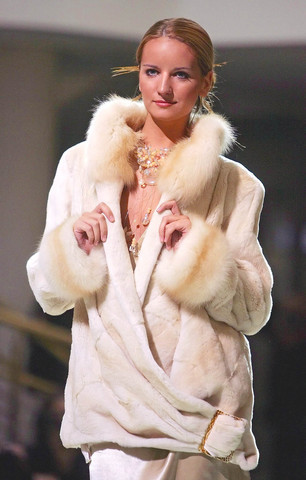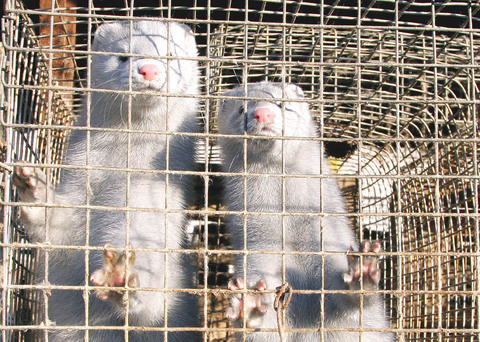From Soviet leaders to high society icons, a Russian fur coat was once seen as a desirable status symbol. But as Russians increasingly favor foreign imports, the Pushkino fur farm near Moscow is barely surviving.
The problems of Russia's fur industry are unrelated to ethical scruples of the kind that have put the industry under pressure in the West. It is the sector's inability to keep up with Western brands since the collapse of communism that is the real problem, observers say.
The farm at Pushkino was once the most celebrated in the Soviet Union. But a glance at its run-down buildings shows how far things have slipped.

PHOTO: EPA
"When I came here a year-and-a-half ago I was shocked," said Nikolai Yumanshev, a former space industry official recently installed as chief executive.
Yumanshev was brought in when the farm was bought by an energetic young millionaire, Denis Lavrov. It had already declared bankruptcy.
Even now, dealing with a legacy of neglect left by the previous state, management is proving an uphill task.

PHOTO: AFP
The animals at the farm were underfed, the mothers were giving birth to fewer and fewer offspring and the quality of the pelts had suffered.
"The water supply system, the electricity, the buildings, the heating system were all rotten," he said.
The picture is similar or worse throughout what remains of Russia's fur industry.
Of the 300 Russian fur farms that once provided 30 percent of world output, around 20 remain. Pushkino is one of just four left in the Moscow region.
"All the fur farms are closing, one after the other. We can't compete with China and Denmark," Pushkino's technical director, Vladimir Kudryavtsev, complained.
"China has taken over the fur market as far west as the Urals and Greek producers sell us poor quality items made from pelts that they buy here," the head of Pushkino's sewing workshop, Alexander Isayev, said.
Officials at Pushkino say they are gradually getting their farm back on track.
It now produces 100,000 pelts per year, including blue and silver fox, mink and sable -- the latter a Russian speciality. Pushkino claims to produce half of all sable -- sable coats fetching as much as US$150,000.
Nonetheless, the buildings remain in disarray and the company appears reluctant to copy Western fashion techniques, such as stret-ching pelts by machine to create a lighter fabric.
Yumanshev says there is still a market for more traditional heavier coats in a harsh climate like Russia's.
"In Europe, women wear furs like jewellery. They are beautiful of course, but in Russia the fur has to be thick and warm -- it's essential," he said. "We work by traditional methods here."
The problems of the company have more to do with the specifics of the Russian business environment, he insists.
These include the enormous size of the country it sells its products in and the farm's distance from the sea. The latter raises the cost of bringing in fish -- an important part of the animals' diet.
There are also difficulties intrinsic to the business, such as the fact that vixen are fertile for just three days per year.
But the biggest problem is the inefficient state bureaucracy.
Yumanshev says he spends much of his time battling local officials in order to obtain licenses and avoid fines for imaginary offenses.
"We get the impression the state is trying to destroy this profession," Kudryavtsev said.

May 26 to June 1 When the Qing Dynasty first took control over many parts of Taiwan in 1684, it roughly continued the Kingdom of Tungning’s administrative borders (see below), setting up one prefecture and three counties. The actual area of control covered today’s Chiayi, Tainan and Kaohsiung. The administrative center was in Taiwan Prefecture, in today’s Tainan. But as Han settlement expanded and due to rebellions and other international incidents, the administrative units became more complex. By the time Taiwan became a province of the Qing in 1887, there were three prefectures, eleven counties, three subprefectures and one directly-administered prefecture, with

It’s an enormous dome of colorful glass, something between the Sistine Chapel and a Marc Chagall fresco. And yet, it’s just a subway station. Formosa Boulevard is the heart of Kaohsiung’s mass transit system. In metro terms, it’s modest: the only transfer station in a network with just two lines. But it’s a landmark nonetheless: a civic space that serves as much more than a point of transit. On a hot Sunday, the corridors and vast halls are filled with a market selling everything from second-hand clothes to toys and house decorations. It’s just one of the many events the station hosts,

Among Thailand’s Chinese Nationalist Party (KMT) villages, a certain rivalry exists between Arunothai, the largest of these villages, and Mae Salong, which is currently the most prosperous. Historically, the rivalry stems from a split in KMT military factions in the early 1960s, which divided command and opium territories after Chiang Kai-shek (蔣介石) cut off open support in 1961 due to international pressure (see part two, “The KMT opium lords of the Golden Triangle,” on May 20). But today this rivalry manifests as a different kind of split, with Arunothai leading a pro-China faction and Mae Salong staunchly aligned to Taiwan.

Two moves show Taichung Mayor Lu Shiow-yen (盧秀燕) is gunning for Chinese Nationalist Party (KMT) party chair and the 2028 presidential election. Technically, these are not yet “officially” official, but by the rules of Taiwan politics, she is now on the dance floor. Earlier this month Lu confirmed in an interview in Japan’s Nikkei that she was considering running for KMT chair. This is not new news, but according to reports from her camp she previously was still considering the case for and against running. By choosing a respected, international news outlet, she declared it to the world. While the outside world